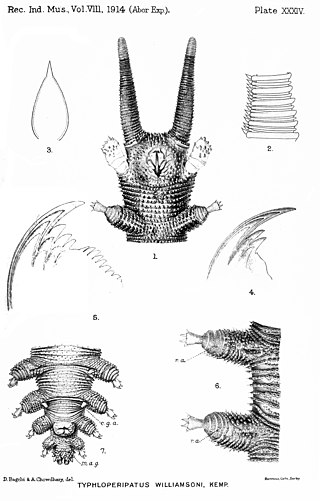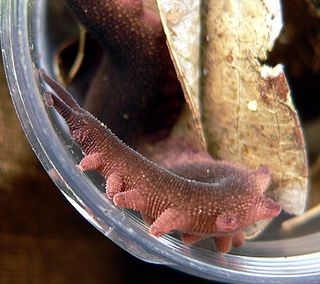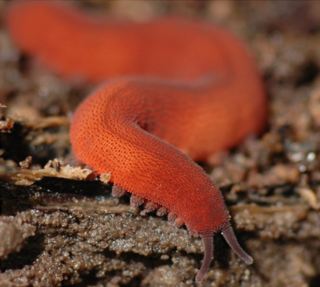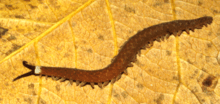
Peripatus is a genus of velvet worms in the Peripatidae family. The name "peripatus" is also used to refer to the Onychophora as a whole, although this group comprises many other genera besides Peripatus. The genus Peripatus is found in Central America, the Caribbean and northern South America. This genus is viviparous, with mothers supplying nourishment to their embryos through a placenta.
Macroperipatus is a genus of Neotropical velvet worms in the Peripatidae family. Velvet worms in this genus can have as few as 24 pairs of legs or as many as 42 leg pairs. This genus is viviparous, with mothers supplying nourishment to their embryos through a placenta.
Mesoperipatus is a monospecific genus of velvet worm in the Peripatidae family, containing a single species Mesoperipatus tholloni. It is found in Gabon, making it the only known species of velvet worm in the tropics of Africa, and the only known species of peripatid velvet worm in Africa. Females of this species have 24 to 27 pairs of legs; males have 23 or 24. This species is viviparous, but too little is known of its embryology to describe its reproductive mode in any more detail; the presence of a placenta, for example, has not been confirmed.
Opisthopatus is a genus of South African velvet worms in the family Peripatopsidae. The number of legs in this genus range from 16 pairs to 18 pairs. The feet in this genus feature three distal leg papillae: one anterior, one posterior, and one median. Mothers in this genus give birth to live young. In particular, this genus exhibits matrotrophic viviparity, that is, mothers in this genus retain eggs in their uteri and supply nourishment to their embryos, but without any placenta.
Plicatoperipatus is a monospecific genus of velvet worm containing the single species Plicatoperipatus jamaicensis. It is endemic to Jamaica. Females of this species can have as many as 43 pairs of legs, the maximum number found in the phylum Onychophora. In a large sample collected in 1988, however, females ranged from 35 to 39 leg pairs, with 37 as the mean and the most common number, and males ranged from 31 to 37 leg pairs, with 35 as the mean and the most common number. This species ranges from 25 mm to 65 mm in length. In the 1988 sample, the mean length for males was 33 mm, and the mean length for mature females was 51 mm. This species is viviparous, with mothers supplying nourishment to their embryos through a placenta.

Typhloperipatus is a genus of velvet worm in the family Peripatidae, containing the sole species Typhloperipatus williamsoni. This genus is notable for containing the only species in the phylum Onychophora found in South Asia. This species is also striking in that this velvet worm shows no external trace of eyes, although rudimentary optical vesicles are present internally.

Peripatidae is a family of velvet worms. This family includes more than 90 described species distributed among 13 genera, but some authorities deem only 80 of these species to be valid. The oldest putative representatives of the family herald from Burmese amber dated to the mid-Cretaceous, around 100 million years ago, with representatives from Dominican and Baltic amber attesting to a broader distribution in the Palaeogene / Neogene; molecular variability suggests that the family's crown group may have arisen in the early Mesozoic.

Eoperipatus is a genus of velvet worms in the family Peripatidae. These velvet worms have been reported from locations throughout Southeast Asia, including Malaysia, Singapore, Thailand, and Vietnam. This genus exhibits lecithotrophic ovoviviparity; that is, mothers in this genus retain yolky eggs in their uteri.

Epiperipatus is the most diverse genus of neotropical velvet worms in the family Peripatidae. Species in this genus are found in Central and South America. This genus is viviparous, with mothers supplying nourishment to their embryos through a placenta.
Heteroperipatus is a genus of Central American velvet worms in the Peripatidae family. The number of legs in this genus varies within species as well as among species and ranges from 26 pairs to 32 pairs. This genus is viviparous, with mothers supplying nourishment to their embryos through a placenta.
Cerradopatus is a monospecific genus of velvet worm containing the single species Cerradopatus sucuriuensis. Males of this species have 28 or 29 pairs of legs; females have 30 to 32. This species is native to the Brazilian savannah. This species is viviparous, with mothers supplying nourishment to their embryos through a placenta.
Paraperipatus is a genus of velvet worms in the family Peripatopsidae. The number of legs vary within species as well as among species in this genus and can range from as few as 21 pairs up to 27 pairs in males and 29 pairs in females. The maximum number of leg pairs recorded in this genus (29) is also the maximum number of leg pairs found in the family Peripatopsidae. This genus exhibits matrotrophic viviparity, that is, mothers in this genus retain eggs in their uteri and supply nourishment to their embryos, but without any placenta. Species in this genus are found in New Guinea and Maluku, Indonesia.
Oroperipatus bimbergi is a species of velvet worm in the Peripatidae family. The female of this species has 27 or 28 pairs of legs, usually 27; the male has 24 or 25 usually, rarely 26. The type locality is in Colombia.
Oroperipatus bluntschli is a species of velvet worm in the Peripatidae family. The original description of this species is based on a female specimen measuring 100 mm in length; its 40 pairs of legs are notable for approaching the maximum number (43) recorded in velvet worms. The type locality is in Peru.
Oroperipatus corradoi is a species of velvet worm in the Peripatidae family. Females of this species have 26 to 29 pairs of legs, usually 28; males have 24 to 27. Females range from 14 mm to 60 mm in length, while males range from 14 mm to 25 mm in length. The type locality is in Ecuador.

Oroperipatus eisenii is a species of velvet worm in the family Peripatidae. Females of this species have 27 to 29 pairs of legs, usually 28; males have 23 to 26. Females range from 30 mm to 57 mm in length, while males range from 20 mm to 23 mm. The type locality is found in Brazil and central Mexico.
Oroperipatus lankesteri is a species of velvet worm in the Peripatidae family. This velvet worm is notable for its large size, reaching 82 mm in length. This species is known only from its type locality in the northern Pacific lowlands of Ecuador.
Oroperipatus omeyrus is a species of velvet worm in the Peripatidae family. This species is blackish red on its dorsal surface but lighter and brownish on its ventral surface. The original description of this species is based on female specimens with 24 to 26 pairs of legs and an embryo with 22 pairs of legs. The females range from 16 mm to 22 mm in length. The type locality is in Peru.
Oroperipatus weyrauchi is a species of velvet worm in the Peripatidae family. The original description of this species is based on only two specimens, a male with 40 pairs of legs and a larger female with 38 leg pairs. The type locality is in Peru.
Mongeperipatus is a genus of velvet worms in the family Peripatidae from Costa Rica. The biologists José Pablo Barquero-González, Steven Sánchez-Vargas, and Bernal Morera-Brenes introduced this genus in 2020 to contain the newly discovered type species, M. kekoldi, together with another species, M. solorzanoi. A phylogenetic analysis using DNA sequences placed these two species in their own monophyletic clade. Furthermore, these two species share morphological characters that indicate that these species do not belong in the other genera and instead belong together in a separate genus. The genus Mongeperipatus is named in honor of the Costa Rican biologist Julián Monge-Nájera.






